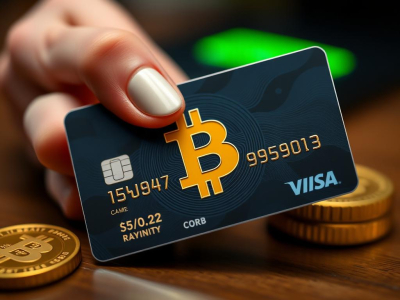
For those looking to make the most of their payment cards, Bitcoin, Ethereum, and Litecoin remain the most popular cryptocurrencies today. Each offers distinct advantages when used for transactions, providing users with flexibility and speed.
Bitcoin leads the pack due to its widespread acceptance and robust security features. Many merchants now accept it directly or through payment processors, making it a practical choice for daily purchases. Ethereum, on the other hand, excels with its smart contract functionality, which can streamline various payment processes.
Litecoin stands out for its faster transaction times and lower fees compared to Bitcoin. This makes it an attractive option for smaller payments or frequent transactions. As you explore your choices for cryptocurrency-based payment cards in 2023, consider these three as your go-to options.
Best Options for Daily Use
Bitcoin (BTC) remains the most recognized cryptocurrency, making it a solid choice for daily transactions. Its widespread acceptance ensures that users can easily convert BTC to fiat through various payment cards.
Ethereum (ETH) is another strong contender, offering speed and flexibility. With many platforms supporting ETH-based transactions, it's popular among users who prioritize quick payments.
Litecoin (LTC), often referred to as the silver to Bitcoin's gold, boasts faster transaction times and lower fees. This makes LTC a practical option for everyday purchases on payment cards.
Ripple (XRP), designed primarily for cross-border transactions, is gaining traction due to its efficiency in moving money across borders rapidly. Many payment solutions now support XRP, enhancing its usability.
Stablecoins, such as Tether (USDT) and USD Coin (USDC), offer stability against market volatility. These are ideal for those looking to use cryptocurrencies without the risk of price fluctuations affecting their purchasing power.
Analyzing these options today reveals that Bitcoin and Ethereum lead in terms of availability and acceptance, while Litecoin, Ripple, and stablecoins provide valuable alternatives tailored for specific needs in daily financial activities.
Integration with Payment Systems
To maximize usability, integrating popular cryptocurrencies with established payment systems is essential. Cryptocurrencies like Bitcoin and Ethereum have made significant strides in this area, facilitating seamless transactions through platforms such as BitPay and Coinbase Commerce.
Analyzing the current landscape, stablecoins like USDC and Tether are gaining traction due to their stability against fiat currencies. Their integration allows for faster processing times and reduced volatility in daily transactions.
Today, many financial institutions are exploring partnerships with cryptocurrency providers to offer more flexible card solutions. For example, Visa and Mastercard have begun accepting certain cryptocurrencies directly, enhancing user experience for cardholders who prefer digital assets over traditional currencies.
Furthermore, mobile wallets such as Trust Wallet and MetaMask are integrating with payment systems to streamline cryptocurrency payments at physical stores. This trend enables users to pay effortlessly using their cards linked to these wallets while taking advantage of crypto benefits.
Adopting cryptocurrencies in payment systems not only caters to tech-savvy consumers but also positions businesses favorably in a competitive market. As adoption increases, it’s advisable for users to stay informed about which cards support their preferred cryptocurrencies for everyday use.
Security Features Explained
For those analyzing popular cryptocurrencies for payment cards today, security features are paramount. Look for cryptocurrencies that implement multi-signature technology, which requires multiple private keys to authorize transactions, adding an additional layer of protection against unauthorized access.
Another essential feature is the use of decentralized networks, which reduces the risk of centralized points of failure. Cryptocurrencies like Bitcoin and Ethereum utilize robust blockchain technology that ensures transaction integrity through consensus mechanisms.
Consider options with built-in encryption protocols. These protocols safeguard sensitive data during transactions, making it difficult for malicious actors to intercept or manipulate information. Privacy coins such as Monero and Zcash excel in this area, offering enhanced anonymity for users.
Two-factor authentication (2FA) is a must-have when using payment cards linked to cryptocurrencies. This adds an extra verification step before any transaction can be completed, significantly mitigating risks associated with account hijacking.
Regular audits and compliance with established security standards also indicate a commitment to user safety. Ensure that the cryptocurrency platforms you choose conduct frequent third-party assessments to identify vulnerabilities.
Lastly, look for active community engagement and prompt incident response protocols. A responsive development team can address vulnerabilities quickly, maintaining trust among users in an ever-evolving digital landscape.
Fees and Transaction Costs
Analyzing the fees associated with cryptocurrencies for payment cards is crucial for maximizing value. Today, several factors influence transaction costs, including network congestion and the specific cryptocurrency used.
- Bitcoin: Transaction fees can vary widely, often ranging from $1 to $20 during peak periods. It's advisable to monitor the mempool to gauge current conditions.
- Ethereum: Gas fees fluctuate significantly, generally between $5 and $30. Users should consider layer-2 solutions like Optimism or Arbitrum to reduce costs.
- Litecoin: Typically features lower fees, averaging around $0.01 to $0.05 per transaction, making it a popular choice for everyday payments.
- Ripple (XRP): Known for minimal transaction costs, usually less than a cent. This efficiency is appealing for businesses utilizing payment cards.
- DASH: Offers instant transactions with fees around $0.01, attracting users who prioritize speed and affordability.
When selecting a cryptocurrency for payment cards, assess not just the nominal fee but also how the cost interacts with the payment system in use. Consider potential hidden charges that might arise during conversion or withdrawal processes.
- Exchange Fees: Be aware of additional costs when converting crypto to fiat currency on exchanges.
- ATM Fees: If using crypto ATMs, expect variable service charges that can significantly inflate overall expenses.
- Merchant Fees: Some merchants may impose their own fees on crypto transactions, impacting the total cost of using a card linked to cryptocurrency.
Selecting cryptocurrencies based on their fee structures and understanding the broader context of transaction costs will enhance your experience with payment cards in 2023.


You can be the first!